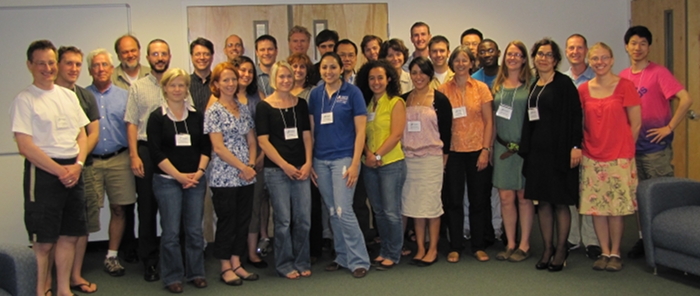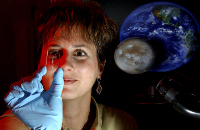| Description | Participants | Agenda | Summary | Presentations | Products |
|---|
NIMBioS Investigative Workshop
Individual-based Ecology of Microbes

Topic: Individual-based Ecology of Microbes: Observations and Modeling
Dates: June 8-10, 2011
Organizers:
• Ferdi L. Hellweger (Civil & Environmental Engineering, Northeastern Univ.)
Expertise: Individual/agent-based modeling of microbes
• Jan-Ulrich Kreft (Centre for Systems Biology, Univ. of Birmingham)
Expertise: Individual-based modeling of biofilms, social behavior of microbes, microbial
ecology
•
Caroline Plugge (Microbial Physiology, Wageningen Univ.)
Expertise: Microbial interaction in anaerobic ecosystems; physiology, molecular biology
and molecular ecology of syntrophic microorganisms
•
Andre Levchenko (Biomedical Engineering, Johns Hopkins)
Expertise: Signal transduction, cell-cell communication, microfluidics.
Objectives. Microbe populations have traditionally been conceptualized as homogeneous collections of identical individuals. This is reflected in our observational approach: biomass is quantified using optical density (OD) or dry weight (mg/L), activity is characterized using bulk chemical measurements (e.g. dissolved oxygen community respiration). Our models also reflect this view. Microbes are described using population-level state variables (e.g. mg C/L) and differential equations (e.g. dC/dt = growth, death, etc.). Growth is considered to be a chemical reaction between a “microbe molecule” and a nutrient molecule to make more microbe molecules. However, advances in single-cell observational techniques, like flow cytometry, microfluidics, fluorescence microprobes, and single-cell genomics, now allow for the observation of individuals within populations. At the same time, individual/agent-based models allow for individuals to be simulated. These new techniques form the foundation of individual-based ecology of microbes. The goal of this workshop was to bring together researchers interested in applying individual observational and/or modeling techniques to study microbial ecology. The workshop addressed several general questions:
- Microbes can now be studied using population-level or individual-based approaches. Are there fundamental differences in the results that can be expected?
- Microbe populations are typically numerous and even individual-based techniques will have to aggregate or upscale at some point (e.g. super-individual, representative area). Is there an appropriate level of aggregation?
- Can a generally-applicable method be developed to determine it?
- A future goal in the area may be to model whole communities of microbes, such as plankton in the world oceans or biofilms of a trickling filter, at the individual level. What specific mathematical or computational hurdles will have to be overcome to do this?
- What are the open biological questions that can be investigated more effectively using the individual-based approach?
- What prevents us from doing this now?
Central theme.The workshop's central theme, individual-based ecology of microbes, is part of an ongoing trend to move from population-level to individual-based approaches in ecology. Early ecological models of organisms at higher trophic levels (e.g. wolves, fish) were based on populations (i.e. Lotka-Volterra). However, the individual-based approach is now well-established. With advances in computing and observing technology, the individual-based approach is now becoming feasible for microbes as well. We anticipate that the individual-based approach will become standard practice for microbes in the future. At present, however, the field is in its infancy. Several research groups have developed their own codes and approaches. Bringing together a number of researchers with interest in this area will accelerate the development of this new field.
 Summary Report.
Participants gave short presentations during the first two days of the workshop. The presentations allowed the participants to introduce themselves and provide their initial views on motivation, challenges, and opportunities for individual-based ecology of microbes. Presentations were grouped into sessions that addressed specific question areas (e.g., interactions with the environment) and technology areas (e.g., microscopy-based methods). Break-out sessions then further addressed motivation, challenges, and opportunities. On the third day, the results of the break-out sessions were reported, followed by synthesis and future directions discussion. The group is currently working on a vision paper on the subject of the workshop, as well as several other follow-on efforts.
Summary Report.
Participants gave short presentations during the first two days of the workshop. The presentations allowed the participants to introduce themselves and provide their initial views on motivation, challenges, and opportunities for individual-based ecology of microbes. Presentations were grouped into sessions that addressed specific question areas (e.g., interactions with the environment) and technology areas (e.g., microscopy-based methods). Break-out sessions then further addressed motivation, challenges, and opportunities. On the third day, the results of the break-out sessions were reported, followed by synthesis and future directions discussion. The group is currently working on a vision paper on the subject of the workshop, as well as several other follow-on efforts.
Evaluation report (PDF)
Products
Publications
Kreft JU, Plugge CM, Grimm V, Prats C, Leveau JHJ, Banitz T, Baines S, Clark J, Ros A, Klapper I, Topping CJ, Field AJ, Schuler A, Litchman E, Hellweger FL. 2013. Mighty small: Observing and modeling individual microbes becomes big science. Proceedings of the National Academy of Sciences, 110(45): 18027-18028. [Online]
van der Wal A, Tecon R, Kreft JU, Mooij WM, Leveau JHJ. 2013. Explaining bacterial dispersion on leaf surfaces with an individual-based model (PHYLLOSIM). PLoS ONE, 8(10): e75633. [Online]
Presentations
Clark J, Field T. 21 September 2011. Informal Workshop: IbMs for Plankton Modelling.
NIMBioS Investigative Workshops focus on broad topics or a set of related topics, summarizing/synthesizing the state of the art and identifying future directions. Workshops have up to 35 participants. Organizers and key invited researchers make up half the participants; the remaining participants are filled through open application from the scientific community. Open applicants selected to attend are notified by NIMBioS within two weeks of the application deadline. Investigative Workshops have the potential for leading to one or more future Working Groups. Individuals with a strong interest in the topic, including post-docs and graduate students, are encouraged to apply. If needed, NIMBioS can provide support (travel, meals, lodging) for Workshop attendees, whether from a non-profit or for-profit organization.
A goal of NIMBioS is to enhance the cadre of researchers capable of interdisciplinary efforts across mathematics and biology. As part of this goal, NIMBioS is committed to promoting diversity in all its activities. Diversity is considered in all its aspects, social and scientific, including gender, ethnicity, scientific field, career stage, geography and type of home institution. Questions regarding diversity issues should be directed to diversity@nimbios.org. You can read more about our Diversity Plan on our NIMBioS Policies web page. The NIMBioS building is fully handicapped accessible.
NIMBioS
1122 Volunteer Blvd., Suite 106
University of Tennessee
Knoxville,
TN 37996-3410
PH: (865) 974-9334
FAX: (865) 974-9461
Contact NIMBioS


